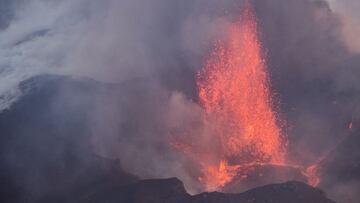La Palma volcano "should be bombed" to divert lava flow
The president of the La Gomera Council, Casimiro Curbelo, has suggested using military jets to bomb the lava flows from the Cumbre Vieja volcano.

The Cumbre Vieja volcanic eruption on the Canary Island of La Palma has seen heightened activity in recent days involving massive earth tremors – one of which, a magnitude 5.0, was the strongest yet recorded – leading to an increase in the lava lake and the number of magma flows following the partial collapse of the upper part of the cone last Saturday. The original lava flows, designated 1 and 4, are the largest spilling from the mountain and are reconfiguring the island with their inexorable advance. There is little the emergency services can do to stop or divert the path of the lava, leading the president of the La Gomera Municipal Council, Casimiro Curbelo, to suggest a drastic strategy: using military aircraft to bomb the flows in an attempt to stop them in their tracks.
“Isn’t there a plane that can fly and drop… and send the lava in a different direction? Maybe its madness, but the technology today is much more reliable and I think it should be attempted. Although it is true it would have to fly at a reasonable altitude, but then it can get close and drop and… boom!” Curbelo reportedly said.
US Army bombed Mauna Loa... but did it work?
In Feb 2020, #Hawaii media reported on a recent discovery of 2 ancient-looking bombs on the north flank of #MaunaLoa. The bombs were part of a 1935 effort to divert #lava and save #Hilo. Read about it in this week’s edition of #USGS #HVO’s #VolcanoWatch, https://t.co/rcKcw9g91c. pic.twitter.com/aeOfmkTVnS
— USGS Volcanoes🌋 (@USGSVolcanoes) March 6, 2020
While the Socialist politician’s idea may seem like a flight of fancy, it is not without precedent. In 1935 the Mauna Loa volcano on Hawaii erupted and threatened the local town of Hilo, prompting volcanologists to request the US Army Air Service, in a mission handed to George S. Patton to oversee, to bomb the lava flows in an attempt to save the town and its water supply, which was under threat from a lava flow advancing at a rate of a mile a day.
While the volcanologist who asked for the air strike, Thomas Jagger of the Hawaiian Volcano Observatory, said the mission had been a resounding success, other experts felt that the slowing of the lava flow and its eventual halting a week after the bombers had done their work was merely coincidental.
Related stories
While the Spanish military has yet to comment on the viability of such a plan, the Cumbre Vieja eruption continues to wreak havoc on La Palma, one of the eight main islands forming the Canary Islands archipelago, where 7,000 people have been evacuated, over 2,000 buildings destroyed and an area of 900 hectares scorched by lava flows, cutting off 66km of roads and decimating the island’s banana crops.
On Tuesday afternoon, the internal cone of the volcano also collapsed, leading to greater emissions from the main vent. However, the local authorities have stated that lava flows continue to follow a trajectory to the west, within the existing exclusion zone, ruling out any further evacuation of residents at the present time. A 4.8 magnitude earthquake was also recorded on Tuesday, the shockwave of which was felt on the neighbouring islands of Tenerife and La Gomera.

